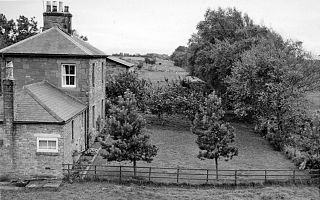
The Ashover Light Railway was a 1 ft 11+1⁄2 in narrow gauge railway in Derbyshire, England that connected Clay Cross and Ashover. It was built by the Clay Cross Company to transport minerals such as limestone, fluorite, barytes and gritstone to its works at Clay Cross and for transport around the country by the LMS.

Llantwit Major railway station is a railway station serving the small town of Llantwit Major, South Wales. It is located on the Vale of Glamorgan Line, 18+1⁄4 miles (29.4 km) west of Cardiff Central towards Bridgend via Barry and Rhoose. The present station opened on 12 June 2005, when passenger services were restored on the section of line between Barry and Bridgend.

Widnes railway station is a railway station serving the town of Widnes, Halton, England. It is recorded in the National Heritage List for England as a designated Grade II listed building. The station is operated by Northern Trains.

Saltaire railway station serves the village of Saltaire near Shipley in West Yorkshire, England. It is situated 3+1⁄2 miles (6 km) north of Bradford Forster Square.

The Exe Valley Railway was a branch line built by the Great Western Railway (GWR) in Devon, England, to link its Bristol to Exeter line with its Devon and Somerset Railway (D&SR), thereby connecting Exeter with Dulverton. The line was in use from 1884 until 1964.

Queensbury railway station was a station on the Queensbury lines serving the village of Queensbury, West Yorkshire, England. The station was unusual due to its triangular shape, and at its opening the only other examples of this arrangement were Ambergate station in Derbyshire and Earlestown in Lancashire; since then Shipley station, also in West Yorkshire, has gained platforms on all three sides. Of the stations on the Queensbury lines, this was the most ambitious.

Brookland Halt was a railway station which served the village of Brookland in Kent, England. The station opened in 1881 and closed in 1967.

Abermule railway station served the village of Abermule in Wales. Served by the Oswestry and Newtown railway, it was situated on the English border. Until 1956 it was the junction for the short branch to Kerry, which had a passenger service until 1931 but was largely built for the local timber traffic.

Boughton railway station served the village of Boughton in Nottinghamshire, England from 1897 to 1955 when it was closed. It has since been razed to the ground.

Adlestrop railway station was a railway station which served the village of Adlestrop in Gloucestershire, England, between 1853 and 1966. It was on what is now called the Cotswold Line. The station was immortalised in the poem "Adlestrop" by Edward Thomas after his train stopped there on 24 June 1914.

Holton Village Halt was a railway halt on the East Lincolnshire Railway which served the village of Holton-le-Clay in Lincolnshire between 1905 and 1961. The station, which opened as part of a new motor train service between Grimsby and Louth, was the second station to serve the village after Holton-le-Clay and Tetney situated further to the south. The line through Holton-le-Clay remained open for freight until December 1980.

Ashover Butts railway station was a railway station serving the village of Ashover in Derbyshire, England. It was the terminus of the 1 ft 11+1⁄2 in narrow gauge Ashover Light Railway.
Shipton-on-Cherwell Halt was a railway halt constructed in 1929 by the Great Western Railway to serve the Oxfordshire village of Shipton-on-Cherwell as well as the adjacent Oxford and Shipton Cement Company limestone quarry and cement works.
The Brill Tramway, also known as the Quainton Tramway, Wotton Tramway, Oxford & Aylesbury Tramroad and Metropolitan Railway Brill Branch, was a six-mile (10 km) rail line in the Aylesbury Vale, Buckinghamshire, England. It was privately built in 1871 by the 3rd Duke of Buckingham as a horse tram line to transport goods between his lands around Wotton House and the national railway network. Lobbying from residents of the nearby town of Brill led to the line's extension to Brill and conversion to passenger use in early 1872. Two locomotives were bought for the line, but as it had been designed and built with horses in mind, services were very slow; trains travelled at an average speed of only 4 miles per hour (6.4 km/h).

Bowness was a station which served Bowness-on-Solway, a village in Cumbria on the English side of the Solway Firth. The station opened on 8 August 1870 by the Caledonian Railway on a line constructed from the Caledonian Railway Main Line at Kirtlebridge across the Glasgow South Western Line, then forming the Solway Junction Railway over the Solway Viaduct to Brayton. The line opened in 1869 and freight had run since 13 September 1869.
Llanharry railway station served the village of Llanharry in the Vale of Glamorgan in South Wales.

Llanbethery Platform was a short-lived railway station in the Vale of Glamorgan, South Wales.
Trerhyngyll and Maendy Halt railway station was a railway halt in the Vale of Glamorgan.
The Llantrisant – Aberthaw line was a railway line built in two parts.
Cowbridge railway station served the town of Cowbridge in the Vale of Glamorgan in Wales between 1865 and 1965. It opened along with the line on 30 January 1865 after multiple delays, which the engineer of the line blamed on bad weather. It was the biggest station on the Llantrisant-Aberthaw line by quite a considerable margin.














